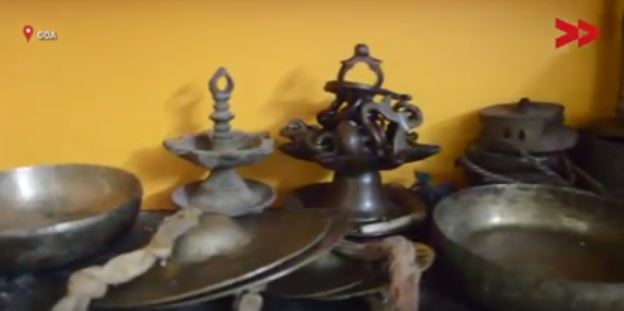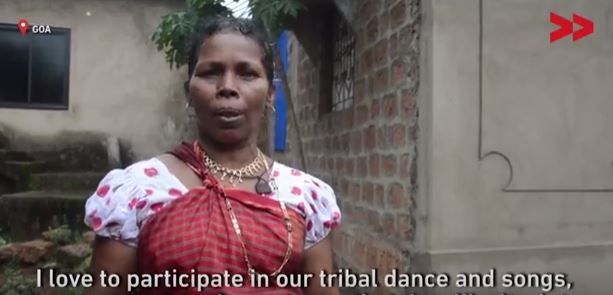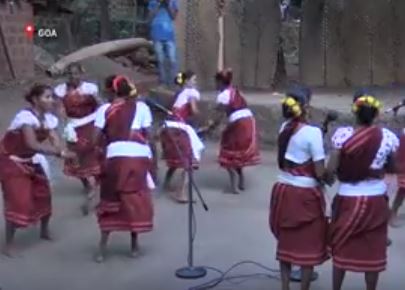The Gauda community of Goa struggles to keep its indigenous culture from eroding in the face of imposed cultural practices and looks at traditional music as the first point of revival.
“The earth is our mother, thus, when the earth yields a good harvest, our women dance and play on the ‘mand’ to acknowledge the gratefulness of mother earth,” says John Fernandes from Ambaulim, the figure at the helm of the struggle for cultural revival. Fernandes explains that the mand is a community stage or platform and that their culture revolves around the earth, the nature and the mand.
"The earth is our mother."
Community Correspondent Devidas Gaonkar follows the story of the Gauda residents of Ambaulim to understand their efforts to restore their culture and identity. After the Portuguese conquered Goa in 1510, they sought to replace indigenous art and culture with Portuguese forms, says Gaonkar. Gaonkar belongs to the Velip community, which is also a tribal community of Goa, and writes and works on issues of tribal culture and identity. His book Govyatil Adivasi Rachna Ani Jivanshaili is a work on the cultures and lifestyles of tribal communities in Goa. Gaonkar explains that around 30% of the population of Goa belongs to the tribal communities of Gauda, Kunbi and Velip. This is the most common categorisation of the tribal population found in literature and Gaonkar adds that while each communities has specific customs, they also have similarities. The tribal communities of Goa primarily live in the hilly areas and collectively practice shifting cultivation; their lifestyle, therefore, is closely linked to the environment.
Gaonkar, talking further about the classification of tribal communities, says that the Gauda community comprises the Hindu Gaudas and the Christian Gaudas. Fernandes talks about the role conversion to Christianity played in the erosion of the local cultures. “We continued to sing and celebrate our cultural songs with some words changed,” he says. Katarina Carvalho, another resident of Ambaulim, adds that the priest in their church told them not to follow their cultural practices and that seemed to be the final nail in the coffin. According to Fernandes, the indigenous culture came under further criticism in the mid-nineties by religious groups and was eventually wiped out.
The Gaudas speak Konkani but with a distinct tone and with some indigenous words and phrases, Gaonkar adds that tribal communities often speak dialects similar to Konkani. The indigenous songs of the Gaudas, along with their oral histories, are passed on in their indigenous language. Fernandes explains that each indigenous song tells a story and documents history. So, in 2010, he turned to music as the first step in reviving the culture of the Gaudas; Fernandes began to collect and repair musical instruments. Another step he took towards reviving traditional Gauda music was consulting community elders over songs and the stories behind them. However, the initiative did not stand unopposed. Local Catholics believe that it is not right for the Gaudas to assert their indigenous culture. For Fernandes and his group, such opposition is not a hindrance and they continue to assert their identity.
[caption id="attachment_15284" align="aligncenter" width="624"] Some of the traditional Gauda instruments being repaired and collected.[/caption]
Some of the traditional Gauda instruments being repaired and collected.[/caption]
The songs have been compiled in a book titled Goycho Mul Avaz or the Real Voice of Goa, and they have, indeed, been successful in lending a voice to an entire community. The Gaudas now perform the traditional dhola in state and national festivals like the National Tribal Festival under the aegis of the Christian Tribal Organisation, and it gives them a sense of being rooted. “I love to participate in our tribal dance and songs,” says Carvalho, adding that many people tell her that they like it too. Fernandes now plans to take his initiative further and one of the first steps is to take Gaonkar’s video to festivals, starting with the Tribal Festival in Ambaulim which is a yearly event. The video will also be shown in scholarship and prize distribution ceremonies organised by the government for students from tribal communities.
[caption id="attachment_15283" align="aligncenter" width="613"] Carvalho is a part of the revival project.[/caption]
Carvalho is a part of the revival project.[/caption]
“Culture is one of the best weapons to unite,” says Fernandes, explaining that culture is a force that helps a community march forward. His choice of words bears testament to the importance of culture in the quest for identity and rights. The Gauda community chose music to make inroads into a struggle for revival, and it eventually led to their traditional attire being revived. The Kunbi saree, which is also worn by the women of the Gauda community, had become a near-extinct weave after the Portuguese conquest. The weave received no patronage because it was not the art of upper caste Hindus. In 2011, Goan designer Wendell Rodricks brought the Kunbi saree to the fashion runway. His project to revive the saree is now under the state government and is a source of livelihood for traditional weavers. Although the saree is now a fashion statement, the revival does not mean that the community can afford it.
[caption id="attachment_15285" align="aligncenter" width="405"] Women of the Gauda community wear their traditional weave and practice a traditional dance.[/caption]
Women of the Gauda community wear their traditional weave and practice a traditional dance.[/caption]
"It's embodied in our soil."
The importance of art forms in reviving a community’s history is recognised, nevertheless. Fernandes is now working towards a museum that can archive and document the history of the tribal communities of Goa. Gaonkar, through his work with tribal communities, reiterates the importance of keeping one’s culture and history alive. It is a question of identity, he says.
“It’s embodied in our soil,” asserts Inas Carvalho speaking about the need for traditional art forms to sustain. The connection to the soil or the earth is strong in most indigenous cultures and is so because of the traditional forms of livelihood and lifestyles in indigenous communities. The tribal communities of Goa, for instance, depend on their land and forests for sustenance. Most songs and customs celebrate the bounty of the earth, as Fernandes points out. A cursory Google search on tribal tours in India will list out a number of tour packages that promise to sell the experience of an indigenous life to the urban traveller, government emporiums sell life-sized figurines of indigenous persons; commercialisation and exoticisation of indigenous cultures are rampant. Does this revive dying indigenous cultures? “Money can buy amusement but not culture”, says Fernandes, putting across the importance of culture and the importance of sustaining it.
The fight for keeping indigenous cultures alive is one that native communities across the world are engaged in. It does not end with the government organising festivals to mark local customs and state officials donning traditional attires and accessories, it is a bigger question of identity and rights and is closely linked to the control of resources.
“Without water, land and forest, where do we go?” is a question that indigenous communities are asking and fighting for, and revival of traditional music is one step towards it. As Fernandes puts it, culture is a force.
Article by Alankrita Anand
Tribal in Kalahandi, Gathered to Protect Kalapat and Khandualmali
The Community Correspondent (CC) Satya Banchor, in this video is showing us a public gathering, where eminent social workers such as Medha Patkar of Narmada Bachao Aandolan are addressing the crowd of villagers, about their environmental rights.
People in Bastar rallying for a Railway line in the Region
They have been demanding a railway line for passengers for the last 50 years. The Bastar Chambers of Commerce and Industries are also a part of this agitation, together with various local organisations and citizens.

